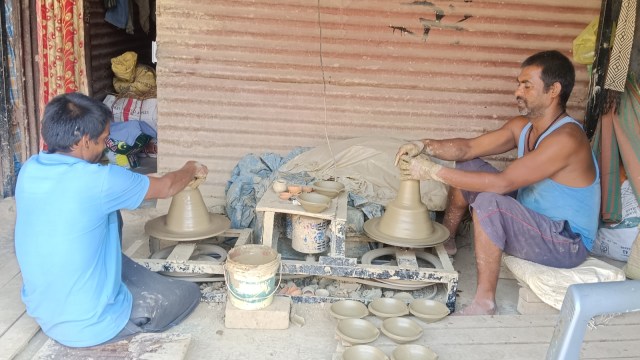Click here to join Express Pune WhatsApp channel and get a curated list of our stories
City of lights | Pune’s potters: How a culture is dwindling due to environmental neglect
Diwali for them once meant days spent molding diyas, idols, and pots, a rhythm of tradition that tied families to their roots
 In Kumbharwada, the decline is visible. Shops that once displayed hand-made earthen diyas now sell glossy, factory-made products sourced from other states (Express Photo)
In Kumbharwada, the decline is visible. Shops that once displayed hand-made earthen diyas now sell glossy, factory-made products sourced from other states (Express Photo)By Ruta Patil
As the festive glow of Diwali begins to warm every corner of Pune, the soft, earthy flame of the city’s potters is dimming. In Khumbharwada, potters across Pune, who once molded earth into beauty, now find themselves struggling against the depletion of the very soil that sustains their art.
“There was a time when we would get soil from Wagholi, Wadgaon Budruk, and Nagar Road. Now we have to travel nearly 300 kilometers to find good clay,” says Prabhakar Shinde, practicing the art for five decades. “At first, soil used to be free. Now it costs us Rs 40,000 a truckload. Even after all this hard work, there’s barely any profit left.”
The actual making of the pots and diyas happens in Mundhwa, where the remaining potters work in small workshops surrounded by spinning wheels and unbaked clay.
Diwali for them once meant days spent molding diyas, idols, and pots, a rhythm of tradition that tied families to their roots. “Our whole family used to work during Diwali,” recalls Somnath Shelar, who has kept the craft alive for more than three decades. “The money we earned was enough to provide for everyone. Now it’s all POP (Plaster-of-Paris), there’s no soul, no connection left.”
The story of Pune’s potters mirrors a larger crisis, the depletion of local soil reserves. Potters say environmental neglect has stripped the land of its rich layers. The once-fertile stretches that supported pottery clusters across the district have turned barren, forcing artisans to depend on soil from other cities as well as states like Gujarat, Rajasthan, and Uttar Pradesh.
 The story of Pune’s potters mirrors a larger crisis, the depletion of local soil reserves. Potters say environmental neglect has stripped the land of its rich layers (Express Photo)
The story of Pune’s potters mirrors a larger crisis, the depletion of local soil reserves. Potters say environmental neglect has stripped the land of its rich layers (Express Photo)
Environmentalist Manisha Sheth, founding director of eCoexist Foundation, explains that this isn’t just an economic problem but an ecological warning. “Clay takes years to form in the natural ecosystem, it’s a non-renewable resource, yet we treat it like something disposable,” she says. “Even clay diyas, which can last for years, are thrown away after one use. When we over-extract and over-consume, we push our resources beyond their capacity. The only way to protect them is to recognise their value, reduce consumption, and reuse more consciously.” Her words shed light on the reality of the business itself and contribute to the issues.
“Even farmland soil is losing its fertility,” says Santosh Kumbhar, who has been working with clay for over 50 years. “There’s more water in the soil now, the good, fertile soil from Maharashtra is almost gone.”
This shift has not only raised costs but also broken cultural continuity. Where once children learned the craft by their parents’ side, many now turn away from it altogether. “The younger generation doesn’t see a future in this,” says Ajay Kumbhar, who has been in the trade for 30 years. “When the soil itself is slipping away, who will keep this art alive?”
In Kumbharwada, the decline is visible. Shops that once displayed hand-made earthen diyas now sell glossy, factory-made products sourced from other states. “People want white soil, polished products, not the black soil we used to work with,” says Vjay Kumbhar, arranging a few remaining clay lamps on his shelf. “Our work is no longer valued, which is why we’ve had to bring items from Gujarat.”
In the corners of Mundhwa’s potters’ sheds, artisans still work through the night, molding what little clay they can find into fragile symbols of faith and continuity. “Day and night, our hands never rest,” says Rushikesh Shinde, a fifth-generation potter. “It’s more than work, it’s our tradition, our culture, our identity. As long as we breathe, this art will live.”
Click here to join Express Pune WhatsApp channel and get a curated list of our stories







